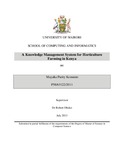| dc.description.abstract | Globally, the importance of knowledge as a means to gain or sustain competitive advantage is increasingly being recognized. Knowledge has become a vital resource. Consequently, there is a growing call for knowledge management (KM). Human capital, which is defined by Wikipedia as the stock of competencies, knowledge, social and personality attributes, including creativity, embodied in the ability to perform labor so as to produce economic value has to be preserved and leveraged to allow for continual learning and improvement. A large number of problems in consulting, advertisement, media, high-tech, pharmaceutical, law, software development, and other human-capital based organizations are attributed to un-captured and un-shared knowledge, the need to know 'who-knows-what', the need for distance collaboration, and the need to capture lessons learned and best practices. In Kenya, agri-business is attracting a growing class of 'peri-urban' farmers and investors who buy or rent land and plant high-yielding crops especially horticultural crops. These emerging farmers need adequate access to knowledge and information in areas of new agricultural technologies, early warning systems (drought, pests, diseases), improved seedlings, fertilizer, credit and market prices. This project outlines the development of a knowledge management system for the upcoming enterprising farmers. The project was geared towards horticultural farmers specifically watermelon, strawberry and mushroom farmers. The knowledge management system developed using Structured System Analysis and Design methodology enables capturing of information from expert farmers through videos, pictures, documents and notes. The knowledge captured was then codified, tagged and categorized in a knowledge base before being disseminated to other farmers through web pages, video recordings and a simple mobile interface. From the pilot data analysis, the solution showed that if adopted, knowledge capture, storage, dissemination and sharing would be scaled up to real-time to the farmers who need it.. | en |

